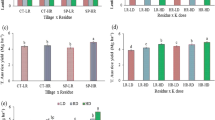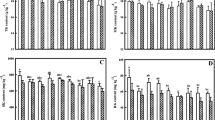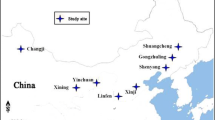Abstract
Intensive cropping in the Eastern Gangetic Plain has progressively depleted soil potassium (K) over time due to negative K balances. There is limited understanding of how alternative soil and crop management practices under Conservation Agriculture (CA) will alter the soil K pools in such soils. We hypothesized that long-term CA will reduce K depletion in soils through recycling and storing soil K. A split plot experiment with two factors—(A) soil disturbance (strip planting = SP and conventional = CT), and (B) residue retention (low, LR = 20 cm and high, HR = 50 cm) commenced in 2010 with three crops per annual cycle for 24 consecutive crops. Soil samples were then collected in December 2018 at 0–5, 5–15, 15–30, 30–45 and 45–60 cm to analyse fractions of K along with soil physical and chemical properties. All K fractions were higher in SP (by 300, 26, 7.8 and 2.4 mg kg−1 for total, non-exchangeable, exchangeable and soil solution K, respectively) than in CT while HR was higher (by 267, 243, 18, 28.8 and 15.9 mg kg−1 for total, mineral non-exchangeable, exchangeable and soil solution K, respectively) than in LR. While increased crop residue retention recycled more K to the soil which partly explains higher concentrations in K fractions, both increased residue retention and decreased soil disturbance increased SOC that can positively increase exchangeable K. Hence, the core components of CA, minimal soil disturbance and increased residue retention, resulted in larger K pools in soil and appear to be effective means for reversing negative K balances in these intensive rice-based cropping systems.



Aus rice (a), the combined mass of rice residue (b) and K input from residue (c) as affected by soil depth, tillage and residue treatments. [Legends: SP strip planting and CT conventional tillage; HR high residue, LR low residue. Error bars represent SE (P < 0.05); Means (n = 4) shown]

Similar content being viewed by others
References
Ali MM, Saheed SM, Kubota D, Masunaga T, Wakatsuki T (1997) Soil degradation during the period 1967–1995 in Bangladesh. II. Selected chemical characters. Soil Sci Plant Nutr 43:879–890
Alam MK, Biswas WK, Bell RW (2016) Greenhouse gas implications of novel and conventional rice production technologies in the Eastern-Gangetic plains. J Clean Prod 112:3977–3987. https://doi.org/10.1016/j.jclepro.2015.09.071
Arfin HF, Tan KH (1973) Potassium fixation and reconstitution micaceous structures in soils. Soil Sci 116:31–35
Askegaard M, Eriksen J, Olesen JE (2003) Exchangeable potassium and potassium balances in organic crop rotations on a coarse sand. Soil Use Manage 19:96–103
Bayer C, Dieckow J, Amado TJC, Eltz FLF, Vieira FCB (2009) Cover crop effects increasing carbon storage in a subtropical no-till sandy acrisol. Commun Soil Sci Plant Anal 40:1499–1511. https://doi.org/10.1080/00103620902820365
Bell RW, Haque ME, Jahiruddin M, Rahman MM, Begum M, Miah MAM, Islam MA, Hossen MA, Salahin N, Zahan T, Hossain MM, Alam MK, Mahmud MNH (2019) Conservation agriculture for rice-based intensive cropping by small holders in the Eastern Gangetic Plain. Agriculture 9:5. https://doi.org/10.3390/agriculture9010005
Black CA (1965) Methods of soil analysis, Part II. Am. Soc. Agron. Madison, Wisconsin, USA
Boehm MM, Anderson DW (1997) A landscape-scale study of soil quality in three prairie farming systems. Soil Sci Soc Am J 61:1147–1159
Bouyoucos GJ (1927) The hydrometer as a new method for the mechanical analysis of soils. Soil Sci 23:343–353
Brammer H, Antoine J, Kassam AH, Van Velthuizen HT (1988) Land resources appraisal of bangladesh for agricultural development. Report-2 (BGD/81/035). FAO of United Nations, Rome, pp 212–221
Bremner JH, Mulvaney CS (1982) Nitrogen-total. In: Page AL, Miller RH, Keeney DR (eds), Methods of soil analysis. Vol.2. Madison (WI). Am Soc Agron, pp 595–624
Chapman HD (1965) Cation exchange capacity. In: Black CA, (ed), Methods of soil analysis. Am Soc Agron, Madison, pp 891–901
Chatterjee BN, Mondal SS (1996) Potassium nutrition under intensive cropping. J Pot Res 12:358–464
Chen JS, Mackenzie AF (1992) Fixed ammonium and potassium as affected by added nitrogen and potassium in three Quebec soils. Commun Soil Sci Plant Anal 23:1145–1159
Darunsontaya T, Suddhaprikarn A, Kheoruenromne I, Prakongkep GRJ (2012) The forms and availability to plants of soil potassium as related to mineralogy for upland Oxisols and Ultisols from Thailand. Geoderma 170:11–24
Dobermann A, Casmann KG, Mamaril CP, Shesby JF (1998) Management of phosphorus, potassium and sulphur in intensive irrigated lowland rice. Field Crops Res 56:113–118
Gami S, Ladha J, Pathak H, Shah M, Pasuquin E, Pandey S, Hobbs P, Joshy D, Mishra R (2001) Longterm changes in yield and soil fertility in a twenty-year rice, wheat experiment in Nepal. Biol Fertil Soils 34:73–78
Haque ME, Bell RW, Islam MA, Rahman MA (2016) Minimum tillage unpuddled transplanting: an alternative crop establishment strategy for rice in conservation agriculture cropping systems. Field Crops Res 185:31–39. https://doi.org/10.1016/j.fcr.2015.10.018
Haque ME, Bell RW, Jahiruddin M., Vance W, Islam MA, Salahin N (2015) Residue handling capacity of the versatile multi-crop planter for two-wheel tractors. In: Proceedings of the conference on conservation agriculture for smallholders in Asia and Africa. 7–11 December 2014, (eds) Vance W, Bell RW, Haque ME (eds) Mymensingh, Bangladesh, pp 13–14
Hasan MN, Bari MA, Lutfar MR (2020) Guideline for soil fertility degradation study including identifying soil fertility trends and measures. SRSRF project. SRDI, Dhaka
Houba VJG, Novozamsky I, Huijbregts AWM, Van der Lee JJ (1986) Comparison of soil extraction by 0.01 M CaCl2, by EUF and by some conventional extraction procedures. Plant Soil 96:433–437
Huq ISM and Shoaib JUM (2013) The soils of Bangladesh. University of Wisconsin-Madison, Springer, Madison, USA
Islam A, Saha PK, Biswas JC, Saleque MA (2016) Potassium fertilization in intensive wetland rice system: Yield, potassium use efficiency and soil potassium status. Int J Agric Papers 1:7–21
Islam MA, Bell RW, Johansen C, Jahiruddin M, Haque ME, Vance W (2022a) Conservation agriculture effects on yield and profitability of rice-based systems in the Eastern Indo-Gangetic Plain. Exp Agric 58(33):1–22. https://doi.org/10.1017/S0014479722000291
Islam MS, Bell RW, Miah MA, Alam MJ (2022b) Unbalanced fertilizer use in the Eastern Gangetic Plain: The influence of Government recommendations, fertilizer type, farm size and cropping patterns. PLoS ONE 17(7):e0272146
Jaskulska I, Romaneckas K, Jaskulski D, Gałęzewski L, Breza-Boruta B, Dębska B, Lemanowicz J (2020) Soil properties after eight years of the use of strip-till one-pass technology. Agronomy 10:1596. https://doi.org/10.3390/agronomy10101596
Knudsen D, Peterson GA, Pratt PF (1982) Lithium, sodium and potassium. pp. 225–246. In: Page AL, Miller RH,Keeney DR (eds), Methods of soil analysis. Part 2. Chemical and Microbiological Properties. Am Soc Agron, Madison. WI
Kovar JL, Barber SA (1990) Potassium supply characteristics of thirty-three soils as influenced by seven rates of potassium. Soil Sci Soc Am J 54:1356–1361
Kushwaha CP, Tripathi SK, Singh KP (2001) Soil organic matter and water-stable aggregates under different tillage and residue conditions in a tropical dryland agroecosystem. Appl Soil Ecol 16:229–241
Liao YL, Zheng SX, Nie J, Xie J, Lu YH (2013) Long-term effect of fertilizer and rice straw on mineral composition and potassium adsorption in a reddish paddy soil. J Integr Agric 12:694–710
Ma Q, Bell RW (2020) CH07—Advances in understanding the potassium cycle in crop production. In: Achieving sustainable crop nutrition (ed. Prof Zed Rengel). Burleigh Dodds Scientific Publishing, Cambridge UK. 27. https://doi.org/10.19103/AS.2019.0062.09
Ma Q, Bell RW, Scanlan C, Neuhaus A (2022) Long-term rundown of soil K reserves in Western Australia requires a re-evaluation of K management in grain production: a review. Crop Pasture Sci. https://doi.org/10.1071/CP21612
Madhukar K, Rakhonde OS, Satyanarayana E, Kumar MS (2017) Effect of tillage and integrated nutrient management on potassium fractions in Vertisol under rainfed cotton. Agric. Update 12(TECHSEAR-3): 653–657; DOI: https://doi.org/10.15740/HAS/AU/12.TECHSEAR (3)2017/653–657
Miah MM, Saha PK, Islam A, Hasan MN, Nosov V (2008) Potassium fertilization in rice-rice and rice-wheat cropping system in Bangladesh. Bangladesh J Agric Environ 4:51–67
Moslehuddin AZM, Hussain MS, Saheed SM, Egashira K (1999) Clay mineral distribution in correspondence with agroecological regions of Bangladesh soils. Clay Sci 11:83–94
Najafi-Ghiri M, Abtahi A (2012) Factors affecting potassium fixation in calcareous soils of southern Iran. Arch Agron Soil Sci 58(3):335–352
Olsen SR, Sommers LE (1982) Phosphorus. In: Page AL, Miller RH, Keeney DR (eds) Methods of soil analisis, Part 2 (Second edition). Am Soc Agron and Soil Sci Soc Am Madison, Wisconsin USA, pp 403–427
Page AL, Miller RH, Keeney DR (1982) Method of soil analysis. Part 2-Chemical and microbiological properties. Am Soc Agron and Soil Sci Soc Am Madison, Wisconsin USA
Panaullah GM, Timsina J, Saleque MA, Ishaque M, Pathan ABMBU, Connor DJ, Humphreys E, Saha PK, Quayyum MA, Meisner CA (2006) Nutrient concentrations, uptake and apparent balances for rice-wheat sequences. III. Potassium. J Plant Nutr 29:173–187
Pettygrove S, Geen ATO’, Southard R, (2011) Potassium fixation and its significance for California crop production. Better Crops 95(4):16–18
Poonia SR, Mehtra SC, Pal R (1986) Exchange equilibrium of potassium in soils. I. Effect of farm yard manure on potassium—calcium exchange. Soil Sci 141(1): 74–83
Rahman MH, Okoba A, Sugiyama S, Mayland, (2008) Physical, Chemical and microbiological properties of a Andisol as related to land use and tillage practice. Soil till Res 101:10–19
Regmi AP, Ladha JK, Pasquin E, Pathak H, Hobbs PR, Shrestha LL, Gharti DB, Duveiller E (2002) The role of potassium in sustaining yields in a long-term rice-wheat experiment in the Indo-Gangetic Plains of Nepal. Biol Fertil Soils 36:240–247
Salam MA, Solaiman ARM, Karim AJMS, Saleque MA (2014) System productivity, nutrient use efficiency and apparent nutrient balance in rice-based cropping systems. Arch Agron Soil Sci 60(6):747–764. https://doi.org/10.1080/03650340.2013.849805
Sarkar B, Singh M, Mandal S, Churchman GJ, Bolan NS (2018) The future of soil carbon (Chapter 3): Clay minerals-organic matter interactions in relation to carbon stabilization in soils, 71–86. https://doi.org/10.1016/B978-0-12-811687-6.00003-1
Sarkar A (1997) Energy use patterns in sub-tropical rice-wheat cropping under short term application of crop residue under fertilizer. Agric Ecosyst Environ 61:59–67
Shaikh K, Memon KS, Akhtar MS (2007) Changes in mineral composition and bioavailability of potassium under long-term fertilizer use in cotton wheat system. Soil Environ 26(1):1–9
Singh B, Singh Y, Imas P, Jian-Chang X (2003) Potassium nutrition of the rice-wheat cropping system. Adv Agron 81:203–259. https://doi.org/10.1016/S0065-2113(03)81005-2
Srinivasarao Ch, Khera MS (1994) Potassium replenishment capacity of some Ustrochrepts at their minimal exchangeable K in relation to clay mineralogy. J Plant Nutr Soil Sci 157:467–470. https://doi.org/10.1002/jpln.19941570612
Taiwo AA, Adetunji MT, Azeez JO, Elemo KO (2018) Kinetics of potassium release and fixation in some soils of Ogun State, Southwestern, Nigeria as influenced by organic manure. Int J Recycl Organic Waste Agric 7:251–259. https://doi.org/10.1007/s40093-018-0211-0
USDA, (2014) Keys to Soil Taxonomy (12th Edition). United State Department of Agriculture. Natural Resource Conservation Service, p 372
Walkley A, Black IA (1934) An examination of the Degtjareff method for determining soil organic matter, and a proposed modification of the chromic acid titration method. Soil Sci 37:29–38
Wang FL, Huang PM (2001) Effects of organic matter on the rate of potassium adsorption by soils. Can J Soil Sci 81(3):325–330
Whitbread A, Blair G, Konboon Y, Lefroy R, Naklang K (2003) Managing crop residues, fertilizers and leaf litters to improve soil C, nutrient balances, and the grain yield of rice and wheat cropping systems in Thailand and Australia. Agri Ecosys Enviro 100:251–263
Whitbread AM, Blair GJ, Lefroy RDB (2000) Managing legume leys, residues and fertilizers to enhance the sustainability of wheat cropping systems in Australia. Soil till Res 54:63–75
World Bank (2021) Commodity Markets Outlook: A World Bank report. International Bank for Reconstruction and Development / World Bank, 1818 H Street NW, Washington, DC 20433. https://www.worldbank.org/
Yadvinder –Singh, Pannu RPS, Bijay S, khind CS (2005) Leaching of K from organic manures crop residues and inorganic fertilizer in two soils under flooded and upland moisture regimes. J Indian Soc Soil Sci 53:207–213
Acknowledgements
We are very grateful to the field and laboratory staff of the Department of Soil Science, Bangladesh Agricultural University, Bangladesh Agricultural Research Institute (BARI) and Project Implementation Office, Bangladesh for their help with soil sample collection, analysis and maintaining the experiment.
Funding
This research was conducted for a PhD study through the financial support of Krishi Gobeshona Foundation (KGF) and Australian Centre for International Agricultural Research (ACIAR) Project LWR/2016/136) for the Nutrient Management on Diversified Cropping System (NUMAN) project.
Author information
Authors and Affiliations
Corresponding author
Ethics declarations
Conflict of interest
The authors declare that they have no known competing financial interests or personal relationships that could have appeared to influence the work reported in this paper. Gender issues were also avoided in publishing this manuscript.
Ethical approval
This article does not contain any studies with human participants or animals performed by any of the authors.
Additional information
Publisher's Note
Springer Nature remains neutral with regard to jurisdictional claims in published maps and institutional affiliations.
Supplementary Information
Below is the link to the electronic supplementary material.
Rights and permissions
Springer Nature or its licensor (e.g. a society or other partner) holds exclusive rights to this article under a publishing agreement with the author(s) or other rightsholder(s); author self-archiving of the accepted manuscript version of this article is solely governed by the terms of such publishing agreement and applicable law.
About this article
Cite this article
Islam, M.J., Cheng, M., Kumar, U. et al. Conservation agriculture in intensive rice cropping reverses soil potassium depletion. Nutr Cycl Agroecosyst 125, 437–451 (2023). https://doi.org/10.1007/s10705-023-10261-5
Received:
Accepted:
Published:
Issue Date:
DOI: https://doi.org/10.1007/s10705-023-10261-5




